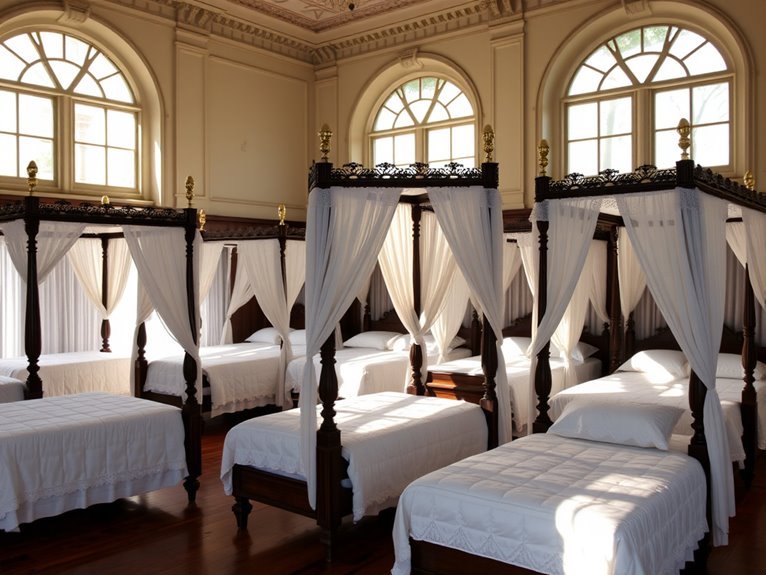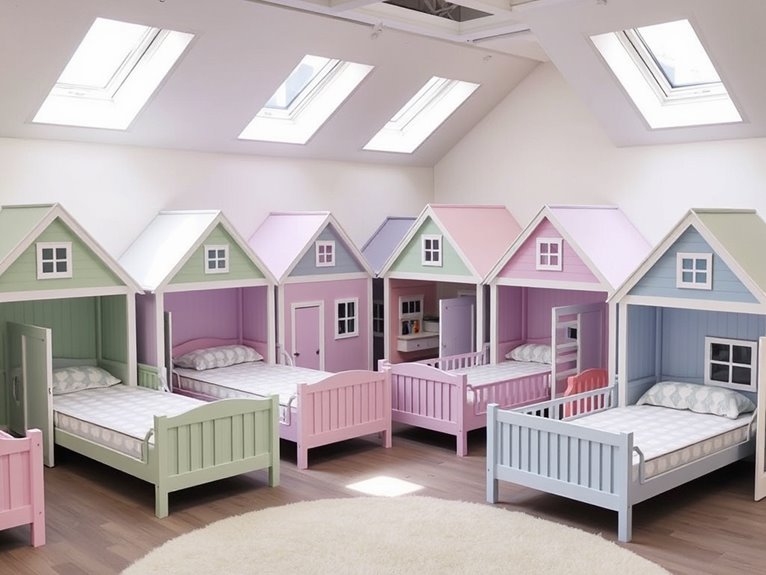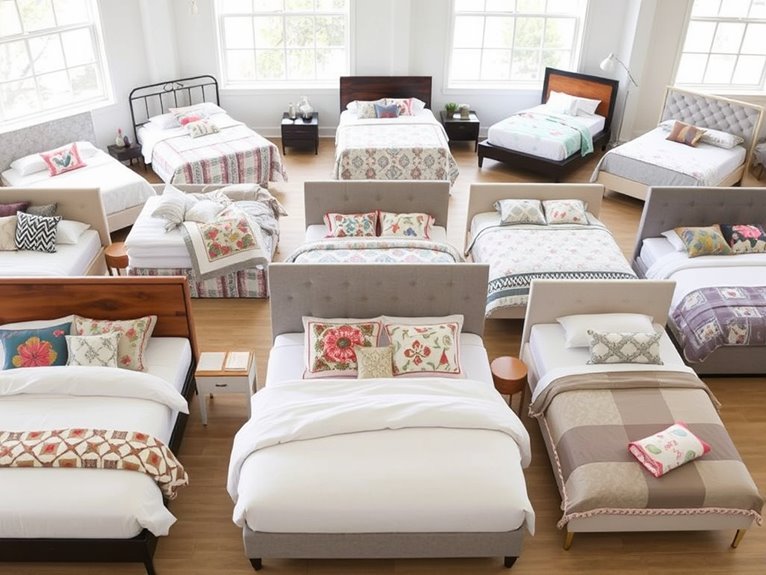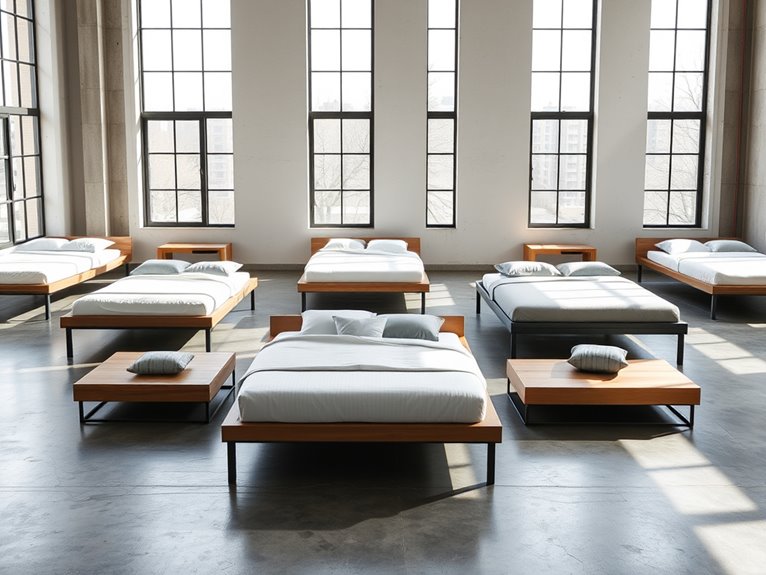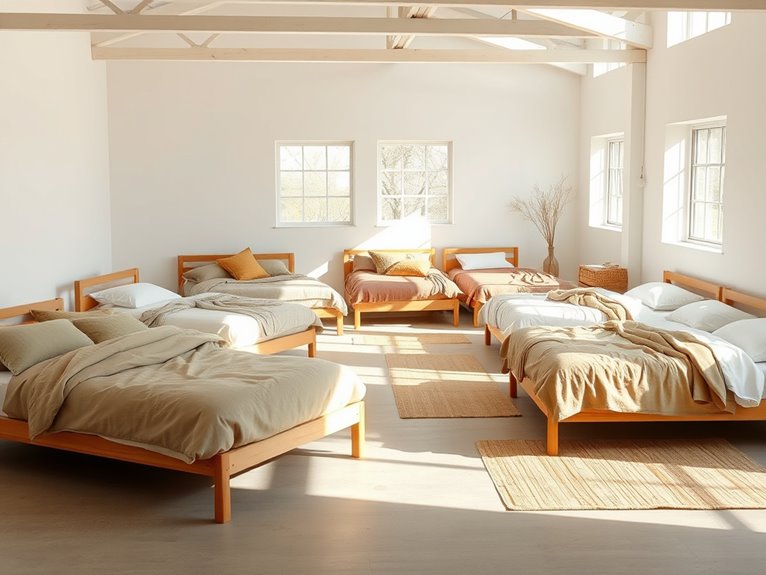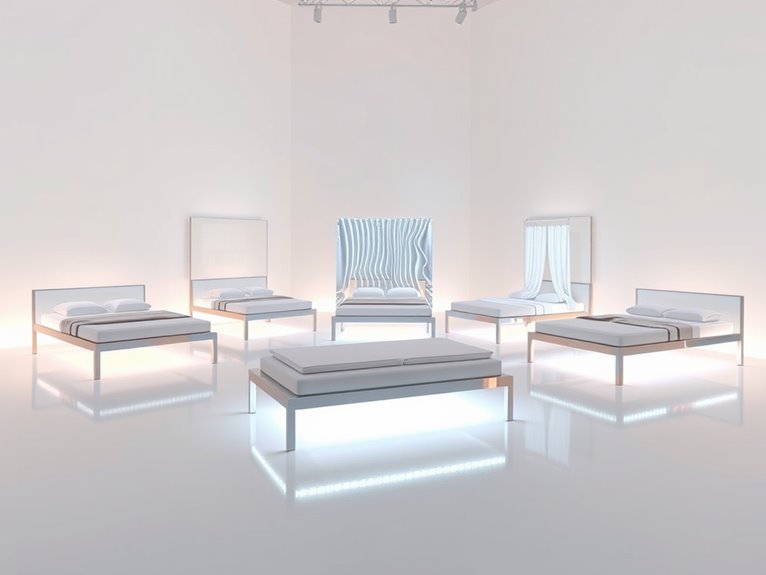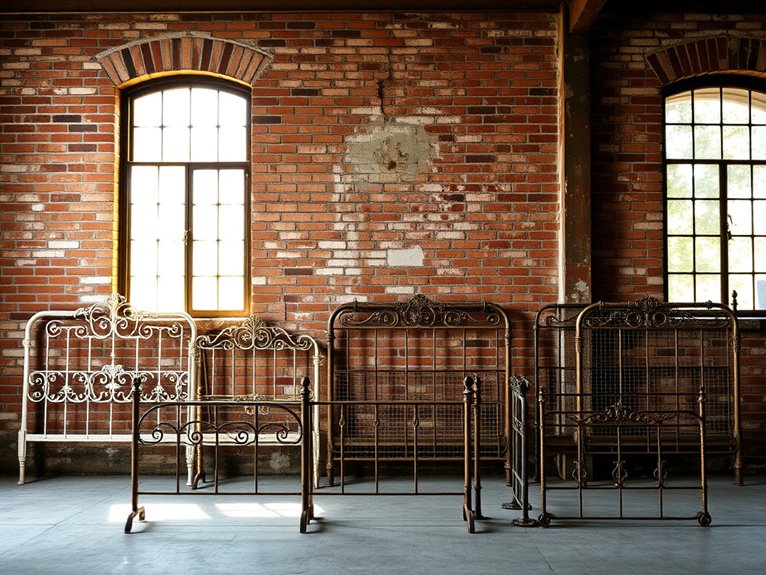7 Tall Canopy Beds
When Sarah moved into her Victorian brownstone, she knew the master bedroom’s soaring 12-foot ceilings called for something spectacular. You’ll find that tall canopy beds don’t just fill vertical space – they transform ordinary bedrooms into luxurious retreats. From ornately carved mahogany posts to sleek industrial frames, these seven stunning designs offer unique ways to frame your sleeping sanctuary. Each style brings its own personality, and you’re about to discover which one will turn your bedroom into a showstopping haven.
Classic Four-Poster Victorian Canopy Bed
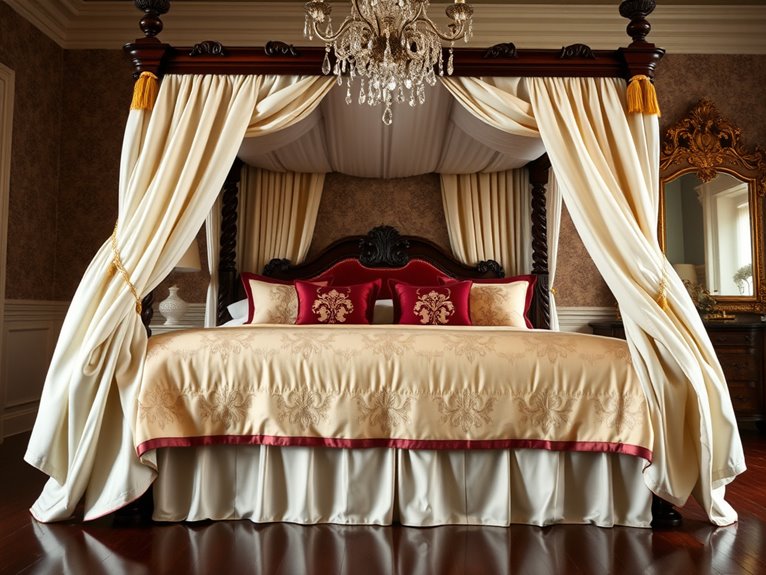
The Classic Four-Poster Victorian Canopy Bed embodies timeless elegance with its dramatic height and ornate architectural details. The imposing vertical posts, often crafted from rich mahogany or walnut, create a regal frame that draws the eye upward, while intricate carvings and finials add architectural interest characteristic of the Victorian era.
The draped fabric panels cascading from the upper frame create an intimate sleeping sanctuary while adding luxurious texture and movement to the bedroom’s design. This sophisticated bed styling technique particularly suits master bedrooms with high ceilings and traditional or vintage-inspired décor schemes. It works exceptionally well in cooler months when heavier fabrics and layered textiles create a cozy atmosphere, though lightweight fabrics can adapt the look for summer.
The style’s versatility allows it to complement both bold Victorian color palettes and subtle modern interpretations while maintaining its classic appeal.
Essential Components:
- Four-poster bed frame with canopy top rail
- Fabric panels for draping
- High-quality mattress and box spring
- Fitted sheet
- Flat sheet
- Duvet or comforter
- Decorative pillow shams (2-3 sets)
- Euro pillows (2-3)
- Standard/queen pillows (2-4)
- Accent pillows (3-5)
- Bed skirt
- Curtain rings or ties
- Drapery pins
- Step ladder
How to Achieve This Look
Begin by ensuring the bed frame is properly assembled and centered in the room. Install the canopy rails securely, as these will support the weight of the fabric panels. When selecting fabric panels, choose materials that complement both the bed frame’s finish and your overall room design – silk, damask, or velvet work particularly well for traditional Victorian styling.
Layer the bedding starting with high-thread-count sheets in white or cream to establish a luxurious foundation. Add a substantial duvet or comforter, preferably in rich jewel tones like burgundy, deep purple, or emerald green for authentic Victorian appeal. The bed skirt should be floor-length and tailored, concealing the space beneath the bed while maintaining the formal aesthetic.
Arrange pillows in descending size order, starting with Euro shams at the back, followed by standard pillows in decorative shams, and finishing with smaller accent pillows in complementary patterns and textures. For the canopy draping, create gentle swags along the rails, allowing fabric to pool slightly at the corners. Popular color combinations include gold with cream, deep red with bronze, or navy with silver accents.
Pro Styling Tips:
For easier maintenance and a more adaptable look, consider using removable canopy panels attached with hidden Velcro strips rather than permanent mounting – this allows for seasonal fabric changes and cleaning. In smaller rooms, opt for sheer panels that won’t overwhelm the space, and keep the color palette light and monochromatic.
To preserve the bed’s pristine appearance, keep extra pillows stored in a nearby chest and maintain only the essential pillows for sleeping, adding the full arrangement for special occasions or photos.
Modern Minimalist Metal Frame Canopy
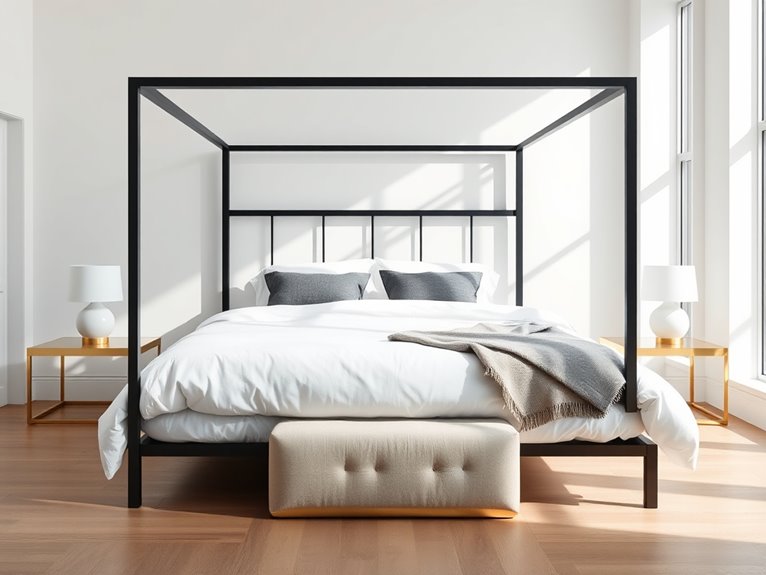
The sleek lines and architectural presence of a modern metal frame canopy bed create a striking focal point while maintaining an airy, uncluttered aesthetic. The clean geometric structure, typically in matte black or brushed metal finishes, draws the eye upward and frames the sleeping space without the heavy, traditional drapery associated with classic canopy beds. This contemporary interpretation celebrates negative space and allows the stark framework to make its own artistic statement.
This styling technique particularly excels in contemporary urban spaces, industrial lofts, and minimalist-inspired bedrooms where simplicity reigns supreme. The metal frame works year-round but especially shines in summer months when lighter bedding can emphasize the bed’s sculptural quality. It’s ideal for rooms with higher ceilings and pairs beautifully with both neutral color schemes and bold accent walls, offering versatility while maintaining its modern edge.
Essential Components:
- Metal frame canopy bed
- Crisp white cotton sheets
- Solid-colored duvet or comforter
- Minimalist pillow shams
- Decorative accent pillows (2-3 maximum)
- Low-profile mattress
- Simple white or gray bed skirt (optional)
- LED strip lighting (optional)
- Modern bedside lamps
- Geometric throw blanket
How to Achieve This Look
Begin with the bed placement, ensuring the metal frame stands perfectly centered against the wall to maximize its architectural impact. Install the frame according to manufacturer specifications, checking all joints are secure and the structure is level. The key is to maintain strict geometric alignment that enhances the minimalist aesthetic.
Layer the bedding starting with crisp, high-thread-count sheets in pure white or light gray. Follow with a solid-colored duvet or comforter in complementary neutral tones like charcoal, taupe, or ivory. Avoid patterns or busy textures that could compete with the frame’s clean lines. The bedding should be pulled taut and corners precisely folded to maintain the modern aesthetic.
Select accent pieces thoughtfully and sparingly. Two to three decorative pillows in monochromatic tones or with subtle metallic elements can add dimension without overwhelming the space. Consider incorporating one geometric throw blanket that echoes the angular nature of the frame. Color combinations that work particularly well include black and white with gold accents, or gray scale with silver elements.
The lighting strategy is crucial for photographing and showcasing this style. Natural light best captures the frame’s clean lines and creates dramatic shadows that highlight the geometric structure. Position modern bedside lamps to create balanced lighting and consider LED strip lighting along the frame’s edges for a contemporary evening ambiance.
Pro Styling Tips
To maintain the minimalist appeal while maximizing functionality, use hidden storage solutions beneath the bed and keep surfaces clear of clutter. For smaller rooms, choose a frame in a lighter metallic finish and use mirrors to create the illusion of more space. During colder months, add warmth through textural elements like a cashmere throw or velvet accent pillows while maintaining clean lines.
Professional designers often suggest placing the bed away from walls in larger rooms to create a floating effect that emphasizes the frame’s sculptural qualities. Daily maintenance is simple – regular dusting of the frame and weekly linen changes keep the look pristine and photo-ready.
Romantic French Provincial Canopy Design
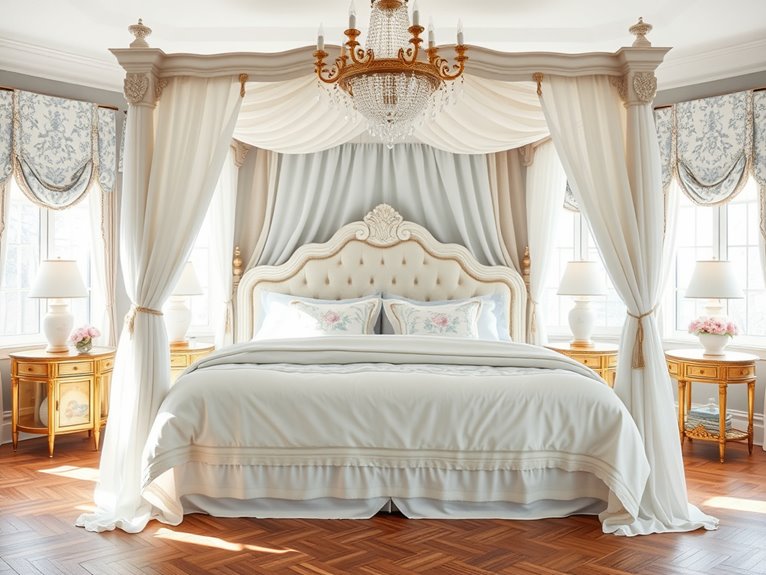
The French Provincial canopy bed style epitomizes timeless elegance, featuring flowing fabrics, delicate patterns, and an ethereal quality that transforms any bedroom into a romantic sanctuary. The signature elements include graceful draping, soft pastel hues, and ornate details that pay homage to the refined aesthetic of 18th-century French countryside estates, creating a dreamy, sophisticated atmosphere that feels both luxurious and invitingly comfortable.
This styling technique works particularly well in bedrooms with high ceilings and natural light, though it can be adapted for various spaces. Perfect for year-round use, it’s especially enchanting during spring and summer months when lighter fabrics and airier arrangements complement the seasonal atmosphere. The style pairs beautifully with both traditional and transitional interior designs, making it versatile enough to evolve with changing decor preferences.
Essential Components:
- White or ivory sheer curtain panels
- Lightweight linen or cotton duvet cover
- European pillow shams (3)
- Standard pillow shams (2)
- Decorative throw pillows
- Tiebacks or curtain holdbacks
- Fabric swags
- Crystal or brass curtain hooks
- Antique-style bedside lamps
- Toile or damask accent fabric
- Silk or satin ribbons
- Step ladder
- Measuring tape
- Curtain rings
How to Achieve This Look:
Begin by measuring and mounting the canopy frame, ensuring it’s centered above the bed and securely attached to the ceiling or bed frame. Install curtain panels on all four corners, allowing extra fabric length for elegant pooling on the floor.
The panels should be hung slightly outside the bed’s perimeter to create an enclosure effect while maintaining an open, airy feel.
Layer the bedding starting with crisp white sheets, followed by a plush duvet in soft cream or pale blue. Arrange European pillows against the headboard, followed by standard pillows in coordinating shams. Add decorative pillows featuring French Provincial motifs like toile patterns or delicate florals in muted blues, roses, or sage greens.
Create visual interest by draping fabric swags across the top of the canopy, securing them with decorative holdbacks. The swags should have gentle curves and subtle gathering points, creating an asymmetrical yet balanced appearance. For added romance, incorporate subtle metallic accents through trimming or small decorative elements that catch and reflect light.
Pro Styling Tips:
For a designer shortcut, use pre-gathered curtain panels with built-in pleating to achieve a polished look with minimal effort. Adapt the style for smaller rooms by using lighter-weight fabrics and fewer layers, focusing on vertical elements to create height.
During warmer months, switch heavy fabrics for gauzy alternatives, and consider removable ties or clips to easily adjust the draping. To maintain the look’s pristine appearance, regularly steam the curtain panels and rotate decorative pillows to prevent wear patterns, keeping spare shams on hand for quick refreshes when needed.
Contemporary Platform Canopy Bed
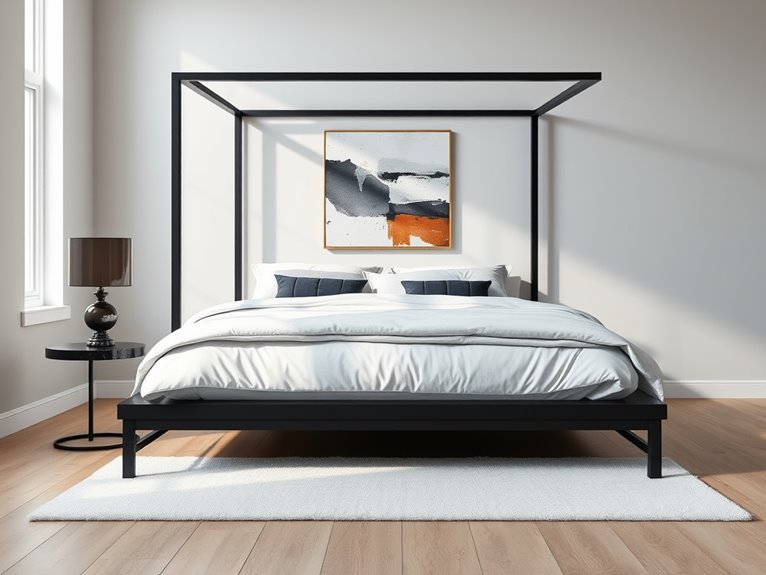
The modern interpretation of a classic canopy bed merges architectural elegance with minimalist design principles. A contemporary platform canopy bed features clean lines, often with a streamlined metal or wooden frame that extends upward to create a dramatic height without the traditional drapery fullness. This striking silhouette creates an immediate focal point while maintaining an open, airy feel that appeals to modern sensibilities.
This styling technique works particularly well in rooms with high ceilings and proves versatile across all seasons. The contemporary platform design especially suits urban lofts, modern apartments, or updated traditional homes where a blend of classic structure and current aesthetics is desired. The style’s adaptability allows it to transition seamlessly from bright summer styling to cozy winter arrangements without requiring major modifications.
Essential Components:
- Platform bed frame with tall posts
- Fitted sheet
- Flat sheet
- Duvet or comforter
- Decorative pillows (2-4)
- Lightweight curtain panels
- Metal or fabric ties
- LED strip lighting
- Minimalist bedside tables
- Modern table lamps
- Abstract artwork
How to Achieve This Look
Begin by positioning the platform canopy bed against the room’s focal wall, ensuring equal space on both sides for balance. Install the frame completely level, as any slight tilt will be noticeable with the vertical posts.
If using curtain panels, attach them with simple ties or minimal hardware that won’t detract from the clean lines of the frame. Layer the bedding starting with crisp, high-thread-count sheets in solid colors or subtle patterns. Choose a duvet or comforter that sits cleanly within the platform frame’s edges, avoiding excessive overhang.
Modern geometric patterns or solid colors in neutral tones like charcoal, taupe, or white create the most contemporary effect. Accent pillows should be minimal in number but bold in impact.
For optimal visual impact, consider monochromatic color schemes with texture variations, or incorporate one bold accent color against a neutral base. Popular combinations include charcoal with copper accents, pure white with black frame details, or warm grey with navy blue touches.
When photographing the style, capture angles that emphasize the vertical lines and negative space created by the frame structure.
Pro Styling Tips
To maintain the contemporary look while maximizing functionality, invest in hidden storage solutions beneath the platform and choose bedding with precise measurements to avoid bulk or overflow. Adapt the style seasonally by switching accent pillows and adding a lightweight throw in summer or a plusher blanket in winter.
For smaller rooms, select a frame with a slimmer profile and use light-colored bedding to create the illusion of more space. Keep the look pristine by implementing a daily morning routine of quick bed-making and pillow arrangement, focusing on maintaining straight lines and symmetrical placement.
Gothic Revival Carved Wood Canopy
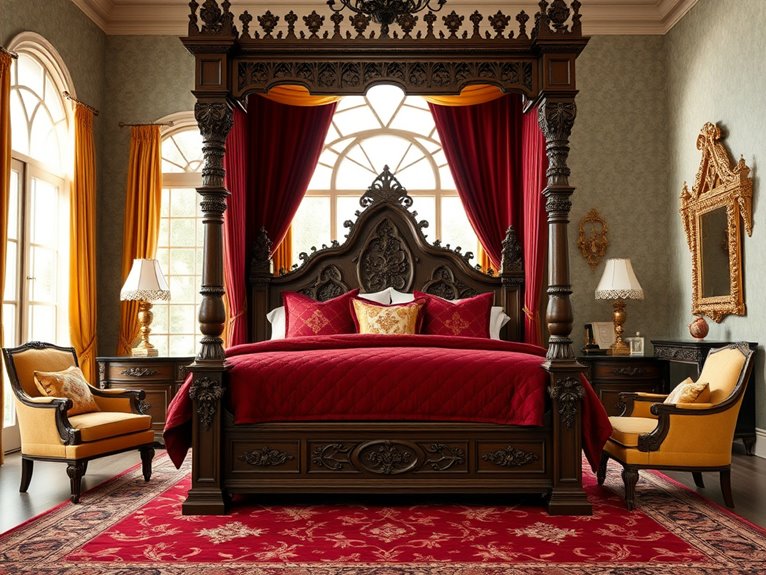
The dramatic elegance of Gothic Revival carved wood canopy beds commands attention with their soaring vertical lines, intricate spires, and ornate architectural details reminiscent of medieval cathedrals.
The dark, richly carved wood creates an imposing silhouette that transforms an ordinary bedroom into a romantic sanctuary, while the elaborate tracery and quatrefoil patterns cast enchanting shadows across the space, especially when illuminated by ambient lighting.
This styling technique works particularly well in rooms with high ceilings and traditional architectural elements, making it ideal for Victorian-era homes or spaces seeking old-world grandeur.
The Gothic Revival style shines during autumn and winter months when deeper colors and heavier fabrics naturally complement the ornate woodwork, though it can be lightened for summer with ethereal fabrics and lighter color palettes. This dramatic bed treatment suits formal master bedrooms and heritage properties where historical authenticity is desired.
Essential Components:
- Heavy carved wood canopy bed frame with Gothic details
- Velvet or damask bed curtains
- Silk or brocade bedspread
- Multiple decorative pillows in varied sizes
- Tasseled tie-backs for curtains
- Cathedral-inspired finials
- Bronze or brass hardware
- Heavy silk or velvet drapery panels
- Period-appropriate bed linens
- Antique-style area rug
- Gothic-inspired wall sconces
- Bedside tables with marble tops
How to Achieve This Look
Begin by positioning the bed against the room’s focal wall, ensuring adequate space around all sides for the dramatic curtains to flow properly.
Install the canopy frame securely, checking that all carved elements align symmetrically. The bed’s orientation should maximize the impact of natural light on the carved details while creating balanced sight lines throughout the room.
Layer the bedding starting with high-quality linens in cream or ecru, followed by a substantial bedspread in deep jewel tones such as burgundy, forest green, or royal purple.
Add decorative pillows in complementary patterns, incorporating Gothic motifs like trefoils or fleur-de-lis. The pillows should graduate in size from largest at the back to smallest in front, creating a luxurious cascade effect.
For the canopy curtains, select fabrics that enhance the period aesthetic while providing the right weight and drape. Deep-colored velvets or damasks work well, especially when paired with contrasting silk panels.
Install curtains using proper hardware and ensure they can be drawn fully open or closed. Consider colorways that complement both the wood tone and existing room decor – rich golds, deep crimsons, and midnight blues are particularly effective.
Pro Styling Tips
To maintain the Gothic Revival aesthetic while preventing the room from feeling overwhelming, incorporate mirrors with pointed arch details to reflect light and create the illusion of additional space.
For summer months, switch heavy curtains for lighter silk panels while maintaining the formal structure, and consider using removable pillow covers in lighter fabrics to adjust for seasons.
Keep the bed linens pressed and curtains regularly steamed to preserve the formal appearance, and install discrete ties or hooks to manage the curtains during daily bed-making without stressing the fabric or hardware.
Industrial-Style Steel Canopy Frame
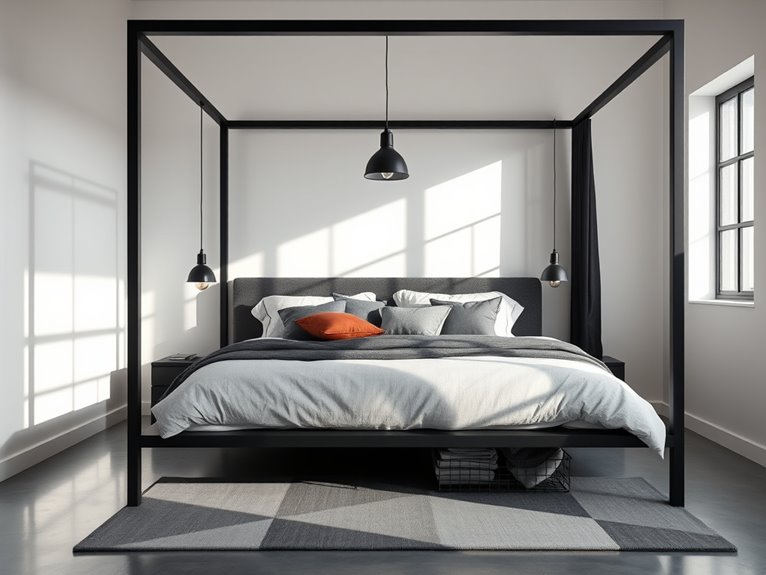
The raw, architectural appeal of an industrial-style steel canopy frame creates a bold statement in any bedroom, combining minimalist design with urban sophistication.
The clean lines of exposed metal framework, typically in matte black or gunmetal finishes, offer a striking contrast against soft bedding while creating a dramatic vertical presence that draws the eye upward and makes any room feel more expansive.
This styling technique works particularly well in contemporary urban spaces, loft apartments, or any bedroom seeking to embrace modern industrial aesthetics. The versatile nature of steel frames allows them to complement various design styles throughout the year, from crisp white linens in summer to layered textures in winter, while maintaining their architectural integrity and statement-making presence.
Essential Components:
- Steel canopy frame with industrial finish
- High-thread-count white bedding set
- Charcoal gray or black duvet cover
- Industrial-style pendant lights or sconces
- Metal mounting hardware
- Factory-style accent pillows
- Natural fiber throw blanket
- Black or metallic curtain panels
- Wire baskets for storage
- Level and measuring tape
- Power drill and mounting screws
How to Achieve This Look
Begin by properly mounting the steel frame, ensuring all connections are secure and perfectly level.
The frame should be positioned to create a balanced negative space above the bed while maintaining proper proportions with the room’s ceiling height.
Consider the frame’s finish – matte black provides the most authentic industrial look, while brushed steel offers a softer alternative.
Layer the bedding starting with crisp white sheets as your foundation, followed by a structured duvet in deep, urban colors like charcoal, slate, or navy.
The contrast between the rigid frame and soft textiles creates visual tension that defines this style.
Add geometric-patterned pillows in coordinating industrial tones, incorporating materials like leather, canvas, or metallic fabrics.
Enhance the industrial atmosphere by incorporating complementary lighting fixtures, such as Edison bulb pendants or articulating wall sconces mounted within the frame’s perimeter.
When photographing the setup, capture angles that emphasize the frame’s strong geometric lines and the interplay between hard and soft elements.
Morning light often best highlights the metallic elements while casting dramatic shadows that enhance the industrial aesthetic.
Pro Styling Tips
For maximum impact, maintain negative space around the frame rather than overcrowding with accessories – less is more with industrial style.
Scale the frame’s thickness to your room size: thinner frames for smaller spaces, substantial ones for larger rooms.
Keep the look fresh by switching textiles seasonally while maintaining the core industrial elements, and prevent dust accumulation on the frame with regular wiping using a microfiber cloth.
For renters, consider free-standing frames that don’t require permanent installation while achieving the same striking effect.
Mid-Century Walnut Canopy Masterpiece
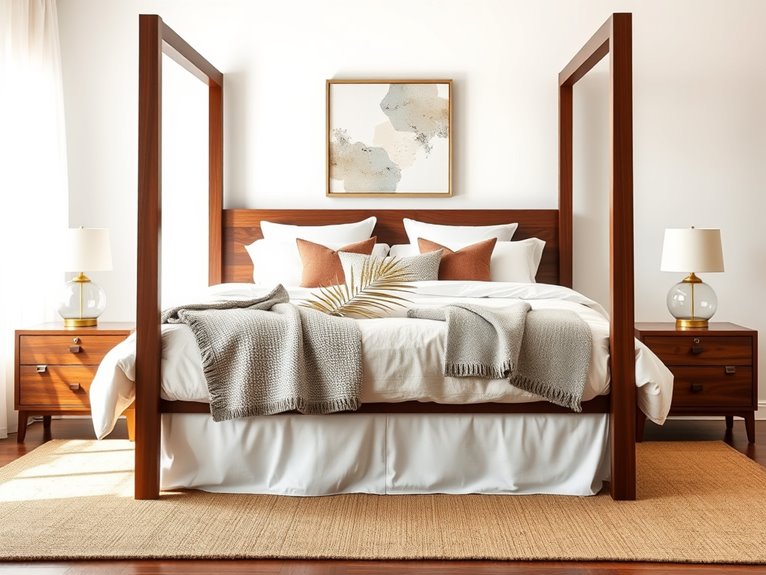
The mid-century walnut canopy bed creates a stunning architectural focal point that marries clean modernist lines with the dramatic height of traditional canopy beds. The warm, rich tones of walnut wood paired with crisp geometric forms epitomize mid-century sophistication, while the negative space between posts creates an airy, almost sculptural quality that draws the eye upward and makes any bedroom feel more expansive.
This styling technique works particularly well in contemporary spaces with high ceilings and minimal decor, allowing the bed’s dramatic silhouette to take center stage. Perfect for year-round styling, this look especially shines during fall and winter when warm wood tones and layered textiles create a cozy yet sophisticated atmosphere. The style adapts beautifully to both urban lofts and suburban homes, providing architectural interest without overwhelming the space.
Essential Components:
- Walnut canopy bed frame
- White percale sheets
- Textured neutral duvet cover
- Linen bed skirt
- Geometric throw pillows
- Woven throw blanket
- Brass accent pieces
- Modern table lamps
- Natural fiber area rug
- Wall art with clean lines
- Clear glass vases
- Minimalist curtain panels
How to Achieve This Look
Begin by positioning the walnut canopy bed against the focal wall, ensuring equal space on both sides for symmetry. Layer the bed with crisp white sheets as your foundation, followed by a neutral-toned duvet in natural materials like linen or cotton. The bed skirt should barely touch the floor, maintaining clean lines while concealing under-bed storage.
Build the pillowscape starting with standard pillows in white cases, followed by Euro shams in textured fabrics that complement the wood tone. Add geometric throw pillows in muted colors like slate blue, warm gray, or terra cotta to reference mid-century color palettes. Drape a textured throw blanket across the foot of the bed at a slight angle for casual sophistication.
Complete the look by styling the surrounding space with intentional minimalism. Place matching walnut side tables with simple brass lamps to frame the bed. Hang abstract art pieces that echo the bed’s clean lines, and consider adding sheer curtain panels that softly filter light without competing with the bed’s architectural presence. The color palette should stay within warm neutrals, with occasional pops of muted color in accessories.
Pro Styling Tips
For maximum impact, elevate the entire bed setup on a large natural fiber rug that extends 24 inches beyond each side, creating a defined zone that anchors the piece. During warmer months, swap heavy textiles for lightweight alternatives in the same neutral palette, and add organic elements like a single oversized palm frond in a clear vase.
To maintain the pristine look while keeping the bed functional, invest in multiple sets of neutral bedding and rotate them regularly, keeping spare pillows in vacuum-sealed bags to maintain their shape when not in use. A designer secret is to slightly angle the corner pillows outward to create depth in photographs while maintaining a livable, approachable feel in daily use.
